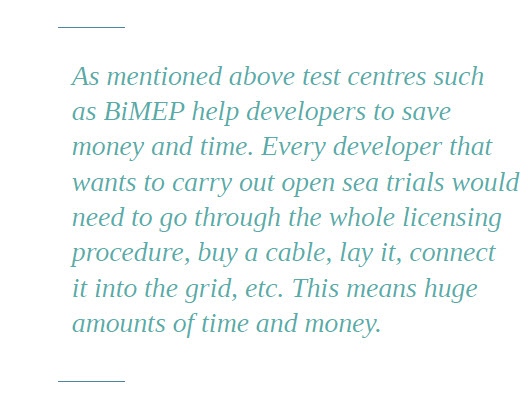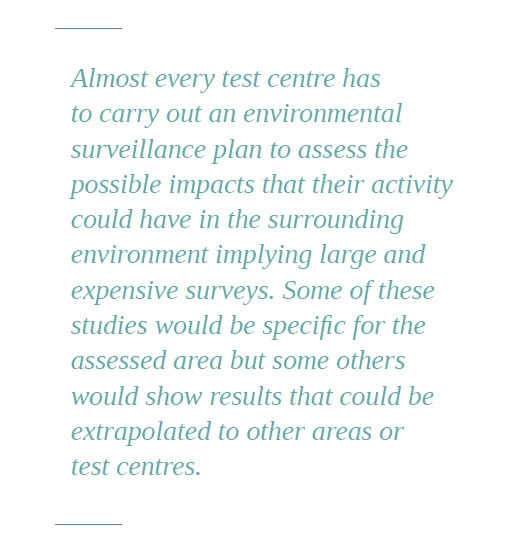Interview with BIMEP - Spain
|
|
YAGO TORRE-ENCISO TECHNICAL DIRECTOR BIMEP |
 What was the motivation and the driving forces to build BIMEP and what milestones were set up for its development? To date, how much funding (public and private) has been granted for its creation and operation?
What was the motivation and the driving forces to build BIMEP and what milestones were set up for its development? To date, how much funding (public and private) has been granted for its creation and operation?
|
The Biscay Marine Energy Platform, BiMEP, was conceived as a project based mainly on three pillars: Today, the need for countries to be more energy independent, and to have a more diverse energy mix, is clear. Consequently, most are establishing renewable policies to this end. On a regional level, The Basque Country is a small and energy dependent region with an increasing energy demand. In some way they want to switch into renewables and in this attempt several of them have focused on marine renewable energy, more precisely in wave energy. Besides, traditionally the Basque Country is a highly industrialized region. Talking about the Basque energy industry, it consists of a big number of companies with an important overall turnover, huge spending in R&D and big international business and, as a coastal country, the Basque shipyards also show relevant figures. As a consequence it can be said that the region had a strong enterprise looking forward to new challenges. |
 |
With all this in mind the Basque energy Agency, EVE, began to look for different options. They realised that off the Basque coast there is very good wave energy resource and started to assess the wave energy market coming to the conclusion that there was actually no market but a big number of different and divergent project ideas far away from commercialisation and that the sector needed to be pushed forward.
 It is recognised that test centres can be instrumental in proving the technology can work in challenging marine environments. What other benefits do you see for developers and also for local/regional communities?
It is recognised that test centres can be instrumental in proving the technology can work in challenging marine environments. What other benefits do you see for developers and also for local/regional communities?
As mentioned above test centres such as BiMEP help developers to save money and time. Every developer that wants to carry out open sea trials would need to go through the whole licensing procedure, buy a cable, lay it, connect it into the grid, etc. This means huge amounts of time and money. When using a test site most of these expenses are reduced or even vanished. For instance, BiMEP is a pre-permitted test site which can be translated into minimum red-tape and BiMEP doing all the reporting
with local and national authorities. So as to have one order of magnitude, the licensing procure of BiMEP lasted 5 years and the time needed by a technology developer from the information to the authorities until their answer is less than three months. Besides, the test site user would only need to pay the test centre fee saving the money from cable purchase, laying and connecting expenses.
Surviving to open sea test campaigns and proving the technology can work in harsh marine environments make developer projects become more credible being more susceptible of attracting private investment. Normally developers follow a phase project development that guarantees the technology readiness level and limits and reduces risks as much as possible. One of the final steps before commercialisation is open sea testing and as a consequence, succeeding to this makes investors more confident favouring the decision of investing into the project.
Another benefit the construction of a test centre brings to local and regional communities is the creation of a new economic activity that can generate new employment in the test centre surrounding area. Sometimes new employees would be directly hired by the testing infrastructure and some other times they would be subcontracted.
The latter is the case of BiMEP. Its philosophy is that if there are already companies that have the skills to carry out the different works we need to develop we subcontract them. Consequently, they acquire knowledge and knowhow that they could use in the future wherever it is needed. This meets one of our main targets which is to consolidate companies in the Basque Country as leaders in the field.
 For ocean energy in general, do you think test centres have a role to play on giving international visibility to the sector? Do you see improvement potential in this respect, and have suggestions?
For ocean energy in general, do you think test centres have a role to play on giving international visibility to the sector? Do you see improvement potential in this respect, and have suggestions?
The ocean energy sector is crowded with hundreds of different ideas but it is true that there are only a few projects that are being tested in open sea conditions. These test are usually carried out in the test sites spread around the world and the media of the different countries transform this information into a piece of news spotlighting the ocean energy sector. Every time a test centre acquires a test campaign, this becomes a piece of news that shows that the sector has made another step forward getting closer to a real market.
 There are several test centres around the world, how do you see the possibility of knowledge sharing between these test centres? Apart from technology-specific details that are usually under non-disclosure, what information could be shared to support the sector?
There are several test centres around the world, how do you see the possibility of knowledge sharing between these test centres? Apart from technology-specific details that are usually under non-disclosure, what information could be shared to support the sector?
|
Sharing knowledge among the different test centres is desirable but difficult to accomplish. Those that have been operating for several years usually don’t want to lose their advantage before those that are already starting their operational phase. In any case, it would be interesting to share the lessons learnt during the different phases of construction and operation without making these test centres lose their competitive advantages. Besides, regarding the environmental aspects, almost every test centre has to carry out an environmental surveillance plan to assess the possible impacts that their activity could have in the surrounding environment implying large and expensive surveys. Some of these studies would be specific for the assessed area but some others would show results that could be extrapolated to other areas or test centres. It seems to be a good idea, in order not to expend twice money and time studying the same |
 |
 Would you like to mention any key lessons from your experience over the operation of the test centre? Have expenses kept reasonably within foreseen limits, or were there any major unforeseen challenges?
Would you like to mention any key lessons from your experience over the operation of the test centre? Have expenses kept reasonably within foreseen limits, or were there any major unforeseen challenges?
BiMEP was inaugurated in July 2015 and since that moment some ocean energy components and equipment have been tested. This last October, the first wave energy converter, the MARMOK-A of Oceantec was installed and connected to the grid. As a result we are just beginning to gain experience over the operation of our test centre.
Regarding the viability plan, it can be said that BiMEP has kept the expenses within foreseen limits as we have not faced major challenges up to the moment.




